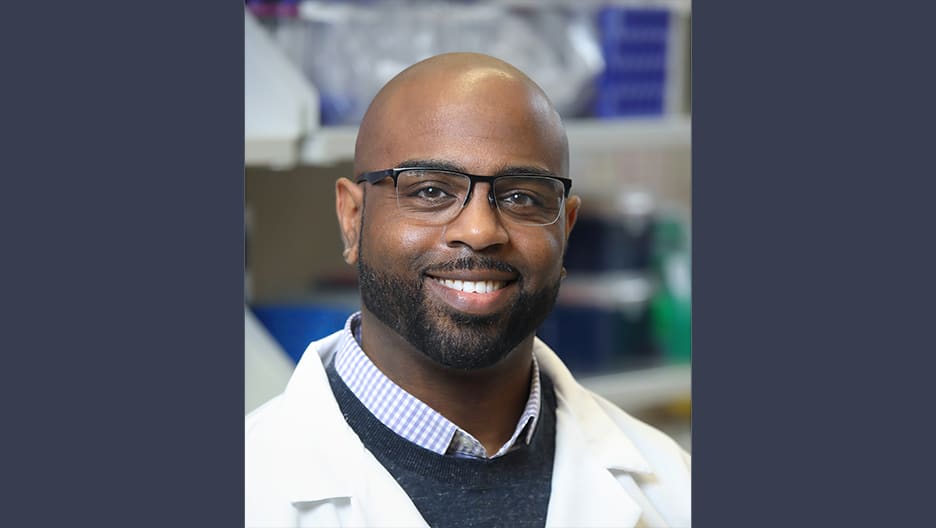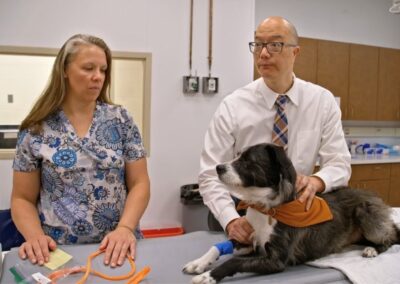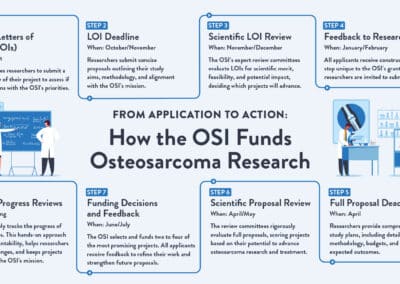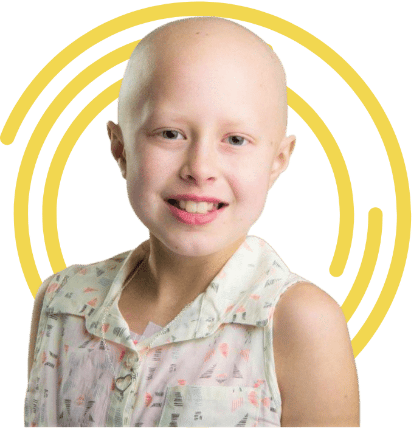“Why don’t children get breast cancer?”
A dissertation committee member posed this question to Troy A. McEachron, PhD, when he was in graduate school. It proved to be a pivotal moment.

Stories of progress, inspiration, and information in overcoming osteosarcoma.

“Why don’t children get breast cancer?”
A dissertation committee member posed this question to Troy A. McEachron, PhD, when he was in graduate school. It proved to be a pivotal moment.
“I did not know the answer,” Dr. McEachron says. “The faculty member said, ‘It is because children are not small adults. Diseases and processes that happen in children are not necessarily the same as those that take place in adults.’ That insight is what nudged me toward taking a pediatric focus.”
Dr. McEachron is an investigator in the pediatric oncology branch of the National Cancer Institute, an NIH distinguished fellow, and head of the integrated solid tumor biology section. The Frontline sat down with Dr. McEachron to hear how his research is pushing the field forward.
After earning his doctorate in molecular and cellular pathology from the University of North Carolina at Chapel Hill, Dr. McEachron pursued a postdoctoral position at St. Jude Children’s Research Hospital, where he delved into pediatric brain tumors. A second postdoctoral fellowship at the Translational Genomics Research Institute focused his research interests further. While working on whole genome sequencing projects, he encountered the stark genomic differences between two bone tumors — osteosarcoma and Ewing sarcoma — and his interest was piqued.
Although both are bone tumors, Ewing sarcoma and osteosarcoma present vastly different genomic landscapes. Ewing sarcoma is characterized by a single genetic translocation, in which part of a chromosome breaks off and attaches to another chromosome. In osteosarcoma, on the other hand, the chromosomal changes are chaotic and complex.
“I was blown away,” Dr. McEachron says. “Here we have two bone cancers that are both aggressive tumors and, genomically, they could not be more different. One is completely silent with its translocation and the other one — osteosarcoma — is a complete mess. That is what got me interested in osteosarcoma. How does a tumor with such genomic instability manage to survive and thrive?”
To this day, that question drives Dr. McEachron’s research at the National Cancer Institute. He believes that understanding the mechanisms that allow osteosarcoma cells to survive despite their genomic chaos will be key to unlocking new therapeutic strategies to improve patient outcomes.
Dr. McEachron studies what is called the tumor microenvironment, which is the surrounding tissues, cells, and molecules that interact with the tumor. After all, tumors do not grow in isolation. They manipulate the environment around them to grow and spread.
For example, advanced osteosarcoma often metastasizes to the lungs, a starkly different environment than the bone it is used to. Within the lungs, osteosarcoma manipulates nearby cells to create a supportive microenvironment. By studying these interactions comprehensively, rather than in isolation, Dr. McEachron hopes to uncover critical insights into tumor survival and progression.
To gain a closer look at a tumor microenvironment, Dr. McEachron uses spatial profiling, an advanced technology that maps molecular interactions within tissue samples. This approach enables him to create a detailed map of a microenvironment that shows how cells communicate with one another and enable — or even support — tumor growth.
— Troy A. McEachron, PhD
Dr. McEachron uses an analogy of mosquito deterrence to explain his approach.
“We can deal with mosquitoes in one of two ways. We can try to kill every mosquito that we see, putting forth a lot of effort. But this will ultimately be unsuccessful because there are way too many mosquitoes and we cannot see them all,” he says.
“Or we can study the mosquitoes, study their habitats, and go after the environment that supports their growth. I think about cancer the same way. How can we make the environment very inhospitable to tumor cells?”
Another aspect Dr. McEachron says plays a crucial role in cancer research is genetic diversity. Different genetic ancestries can influence how diseases develop and respond to treatments, which is why Dr. McEachron says it is necessary to include diverse tissue samples in studies to ensure that findings are applicable to all populations.
Through his involvement in the Childhood Cancer Data Initiative, Dr. McEachron is working to engage underrepresented populations in research. The initiative aims to improve outcomes for all patients by addressing barriers to participation and fostering more inclusive studies.
Despite all the challenges, Dr. McEachron says he is cautiously optimistic about the future of osteosarcoma research. While significant gaps in understanding about the disease remain, he says that advances in technology and interdisciplinary collaborations hold promise for breakthroughs.
“I see some really interesting things on the horizon,” Dr. McEachron says. “I look at my colleagues and at the trainees that are working under us and how incredibly smart they are and how savvy they are with machine learning to uncover patterns that were previously unrecognizable to the human eye. I think there’s a lot to be optimistic about.”
Troy A. McEachron, PhD, is an investigator in the pediatric oncology branch of the National Cancer Institute’s Center for Cancer Research. An NIH distinguished scholar, he serves as head of the solid tumor biology section. His research centers on the microenvironment of pediatric sarcomas, and he leads a translational research laboratory that focuses on understanding the osteosarcoma microenvironment to identify therapeutic targets.

Stay informed as we work to identify new treatments for osteosarcoma.
We never sell or share your information.




Your donation provides immediate and long-term support to osteosarcoma patients.
Sign-up for our newsletter and stay up-to-date about our fight against Osteosarcoma!